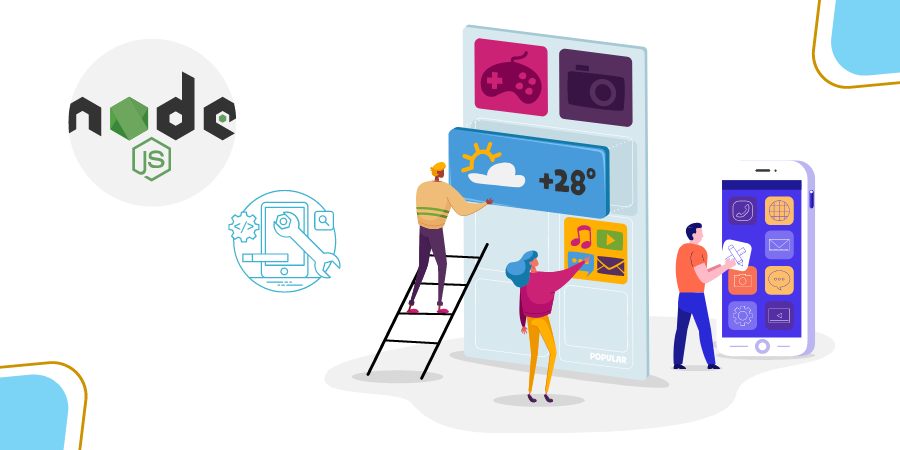
- Monolithic architectures are incapable of scaling.
- Enterprises are grappling to transit between the front and backend, increasing application loading time.
- Efforts are made to expedite application development and deployment and maximize efficacy.
Indeed, putting together a technology stack is a challenging feat. This demands the right blend of languages, tools, and platforms for easily developing an app. Among many, Node.js is a robust framework developed on Chrome's V8 Javascript engine for building fast, high-performing apps such as video streaming platforms, web applications, and single-page apps.
As per the source report, Node.js can lessen the webpage loading time by 50-60%. Many platforms have attained several benefits by adopting Node.js. However, understanding its architecture and best practices for developing apps can help accomplish maximum benefits.
This blog details the Node.js architecture, its component, and best practices that make application development convenient.
Understanding Node.js Architecture at a Glance
Node.js employs a ‘Single Threaded Event Loop’ architecture that indicates all the client requests for Node.js can be processed using a single thread and can handle multiple clients simultaneously.
The node.js processing model follows a Javascript-event-based model and a callback mechanism. This mechanism enables Node.js to conduct blocking I/O operations in a non-blocking manner or simply run complex functions in a simplified way. Additionally, leveraging the single-thread model makes scaling easier than one thread or new thread per user request while loading any web page.

Components of the Node.js Architecture
- Requests: Requests projected to the server can be either blocking or non-blocking (simple) based on the actions a user targets to perform.
- Node.js Server: Node.js server accepts requests, processes them, and returns the outcomes to the respective users.
- Event Queue: Event Queue accumulates the incoming client requests and passes them sequentially to the Event Loop.
- Thread Pool: This incorporates the threads available for performing the operations necessary to process requests.
- Event Loop: This receives requests from the Event Queue and responds to the clients.
- External Resources: These are used to address blocking requests of clients and can be used for computation and storage.

7 Best Node.js Application Development Practices
1. Practice Writing Asynchronous Code
Javascript offers a callback function, passing functions as an argument to other functions. It allows defining an asynchronous behavior- as the number of chained operations increases, the code gets bulky and complicated, and the situation is known as callback hell. To solve this, ES 6 (ECMAScript)designed the Promises API, which enabled asynchronous writing code in Javascript. With ES 8, the async/await syntax was introduced, making APIs more intuitive and natural.
Thereby, eliminating clunky callback functions and using async/await and promise-based syntax in Node.js applications makes the code cleaner, readable, and error-free with a more coherent functional programming setup.
2. Conduct Unit Testing
Testing is a critical stage in application development. The entire development cycle depends on reliable, fail-proof testing, as any bug in the code can slow down the development process and cause other issues.An application must be tested by units aiming to isolate a code section and verify if it’s correct and error-free. In procedural programming, a unit is an individual function or procedure. Unit testing is usually conducted by the developers who write the code.
3. Use Another Layer for Third-party Service Calls
A call to third-party services is often made to retrieve data or perform app operations. If we fail to separate this call into a specific layer, this may result in an out-of-control segment of code, too intricate to handle.
To solve this, the pub/sub pattern is used. This mechanism involves a messaging pattern where we have - publishers (entities sending messages) and subscribers (entities receiving messages).
Publishers don’t program messages to be sent to specific recipients. Instead, they categorize published messages into specific classes without knowing which subscribers are dealing with them.
4. Dependency Injection into Action
Dependency injection is a software design pattern that passes (injecting) dependencies (or services) as parameters to modules instead of necessitating or developing within them. This makes modules more adaptable, independent, reusable, scalable, and testable throughout the application.
Dependency injection streamlines the unit testing process by passing them directly to the modules and makes maintenance easier by avoiding unnecessary module coupling.
5. Employ Gzip Compression
Gzip is a lossless compression mechanism for compressing and transferring files. As Node.js serves heavy-weight web development pages containing multimedia files, Gzip compression decreases load while bolstering the process.
Express.js, a Node.js framework, helps implement this strategy. This compresses the server's response body for each request, resulting in lower latency and much faster websites.
6. Consider APM at Core
Providing a better user experience and high-performant enterprise-level apps using Node.js is critical alongside understanding how users interact with it. This is where APM (Application Performance Monitoring) tools come in handy.
APM assists in monitoring the app's performance, detect errors or bottlenecks that impede the user experience, and provide real-time information.
With proper monitoring and follow-up, an application can perform optimally for a longer period. Some popular Node.js monitoring tools include Appmetrics, Prometheus, Express Status Monitor, and others.
7. Third-party solutions
As a third-party support, Node’.js offers NPM, a feature-rich, well-managed, documented framework. Developers can stuff these existing tools and solutions into their code to improve their APIs.
Advanced tools and libraries that Node.js provides eliminate developer hassles. Some popular Node.js libraries upgrading coding workflows are -
- Nodemon to restart the application when codes are updated
- Agenda for job scheduling
- Moment for working with date & time
Furthermore, it’s recommendable to understand the objective and functionalities of each package (library or tool) we import.
Wrapping Up
In this blog, we have discussed the Node.js architecture and the best node.js application development practices. Following these practices, you can improve your Node.js app performance and efficiency. It will assist you in properly structuring your node.js app development with logging, testing, and developing asynchronous code, among other things.



























 Batoi Corporate Office
Batoi Corporate Office